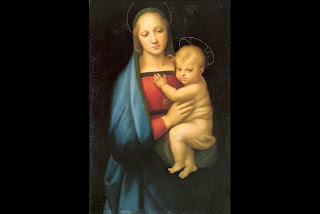8.1.11
Απαντήσεις για την Παναγία του Ραφαήλ
FLORENCE.- An X-ray analysis has shown that the dark background that appears in one of the most famous paintings by Raphael, the Madonna dell Granduca, is not original, but was added by a painter, who is still unknown.
It was until the seventeenth century, that the painting, which is housed at the Pitti Palace in Florence, that in the background of the painting architectural structures and a landscape were seen, according to research done by the Opificio delle Pietre Dure (an art restoration laboratory in Italy), but today only a black background is visible.
Historians agree that Raphael painted this famous virgin shortly after his arrival in Florence in 1505. Overwhelmed by its beauty, Raphael highlights the godlike quality he gives his characters, however, some had argued that the black background in the painting was not the work of Raphael and two thesis existed: one for a black background always existed, the other, that it was added later.
So far the investigation by the Opificio delle Pietre Dure, work funded by the Japanese newspaper Yomiuri Shimbun, noted that the black background was an added touch to the painting by someone in the seventeenth century. The suspicion that the black background was added, was based on all the virgins painted by Raphael from 1505 to 1507, which always have a landscape.
With this analysis, science has shifted the balance and can confirm that the substance was added several years after its creation. Thanks to an analysis by fluorescent x-ray studies with a chemical component of the pigment.
The discovery is considered of great importance because it allows the rewriting of an important page in the history of art. In other words, it shows that even the Madonna dell Granduca, Raphael is influenced by Leonardo da Vinci, which means an adherence to the philosophy of light.
According to Spain's ABC newspaper, the study's authors plan the restoration of oil on the painting and to expose the bottom architectural structures and landscapes that still exist in the painting as shown by x-rays. Now we have to answer the mystery of who painted over one of the most famous paintings by Raphael with a black background and why?
Εγγραφή σε:
Σχόλια ανάρτησης (Atom)

Δεν υπάρχουν σχόλια:
Δημοσίευση σχολίου